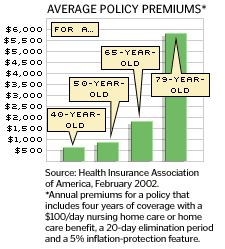
NEW YORK (CNN/Money) -
Long-term care insurance is a little like cod-liver oil. Everyone tells you it's good for you but paying all those premiums can be hard to swallow.
LTC insurance can protect your assets -- and your peace of mind. One look at the cost of a nursing home -- an average of about $61,320 annually, according to the Met Life Mature Market Institute -- and it's easy to see why the number of people buying LTC policies has doubled in the past five years. Policies cover extended care in nursing homes, assisted living facilities, adult day care centers, and even your home. A good policy also covers all types of care, not just skilled medical care but help with daily activities if you become chronically ill or disabled.
But LTC insurance doesn't come cheap. And although it's a smart move for many people, for others it may be a waste of money. Here's what you need to know before you buy.
Who needs it
Unfortunately, there's no black-and-white rule dictating who should buy LTC insurance. "It's a very qualitative decision," said certified financial planner (CFP) Tom Grzymala of Alexandria Financial Associates in Alexandria, Va.

Whether a policy makes sense for you depends on several factors: your net worth; how much of it you're willing to spend on healthcare; how much want to leave to heirs; your marital status; and your age.
Consider your family history, too. If longevity or a chronic disease runs in your family, you may be more likely to require long-term care at some point. And because women live longer than men on average, they are more likely to need nursing home or other extended care.
The idea is to buy a policy before you need one. The older you get, the greater the risk that you may develop health problems and become uninsurable. Even if you do get a policy, premiums will be steep. That's why most financial planners suggest clients buy a policy by their mid-50s or early 60s.
In general, the richer you are the less you need a policy, and the poorer you are the more likely it is that you'll qualify for Medicaid. Between those poles, things get murky.

The United Seniors Health Council suggests you only consider buying a policy if you own assets worth at least $75,000 (excluding your home and car); expect to have an annual retirement income of at least $25,000 to $35,000; can pay premiums without adversely affecting your lifestyle; and can absorb possible premium increases without financial difficulty.
On the other hand, Grzymala said, if your annual investment income is within 10 percent of the cost of a nursing home in your area you may not need coverage. The same goes if you have at least $1 million in investable assets by the time you're 55.
But much depends on your marital status at the time care is required. If you're single, and your expected retirement income won't cover long-term care, LTC insurance may save you from depleting your assets. But if your income is ample enough to cover extended nursing home care and you sell your house to move into the nursing facility, then you may not need it.
By contrast, a married couple's expenses are likely to increase greatly when one spouse needs care because the healthy spouse will spend nearly as much as the couple did together, said CFP Kim Dignum of Fort Worth, Texas. Say a nursing home costs $60,000 a year. You'll need to add that $60,000 to your usual cash-flow needs and determine if your pension, Social Security and investment income combined can cover the additional expense without leaving the healthy spouse high and dry, Dignum said.
What it costs
Nearly a hundred insurance carriers offer LTC insurance, but only about 10 carriers, including John Hancock, GE Capital, and Conseco, sell the majority of policies. Prices vary by region and company, so be sure to shop around. Your best bet is to contact an independent insurance agent in your area who offers policies from a variety of companies. If you don't know a local agent, the major carriers can refer you to one, said John Haslett, president of Haslett Management Group in Reston, Va, an independent insurance agency.

It may sound obvious, but make sure you buy a policy you can afford. Remember you are going to pay those premiums for years to come. If they're too expensive, you may let your policy lapse and will have wasted thousands of dollars. Haslett says a good rule of thumb is to make sure a premium does not exceed 5 percent of your current income.
The younger you are when you buy a policy, the lower your premium. A 50-year-old buying a four-year policy might pay an average of $881 annually, while a 79-year-old buying the same policy would pay $5,895, according to the Health Insurance Association of America.
Beyond your age, how much you pay for LTC insurance depends on at least five factors:
• The dollar-per-day benefit. Coverage ranges from about $50 to $300 a day. Experts recommend you buy at least the difference between the cost of a nursing home in your area and the amount your income can cover. And consider buying a policy that covers all levels of care, including at home, in a nursing home or assisted living facilities.
• Duration of coverage. Most consumers opt for policies that cover two to five years. The longer the coverage period, the higher your premium. Lifetime policies are the most expensive.
| |
 RELATED STORIES
RELATED STORIES
| |
| | |
| | |
|
• How many days you pay for services before the insurance kicks in. Also known as the elimination period or deductible, this can range from 0 to 100 days. The longer the period, the lower your premium. The best policies require that the elimination period only be met once over a lifetime, and let you combine days of home care and facility care to meet the deductible.
• Whether you opt for inflation protection. Experts consider this a must. Haslett recommends consumers opt for a 5 percent inflation rider, not the CPI inflation rider. To guarantee that your daily benefit keeps pace with inflation, a 5 percent rider costs more, but the premium is fixed when you buy the policy. With a CPI option, your premium increases every time there's an inflation adjustment and the increase is based on the newly adjusted benefit level and your age at the time of the adjustment. Because premiums rise sharply with age, it can be a "cost-prohibitive" option, Haslett says.
• Whether you buy "nonforfeiture" protection for missed payments. Some policies let you choose whether to have your coverage stay in effect for a certain period if you miss payments or to have it stay in effect for life but at a reduced benefit. Haslett strongly urges consumers to forego this option, since it can add as much as 40 percent to your premium and doesn't increase the value of your benefits.

|

